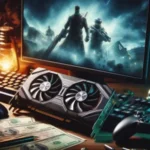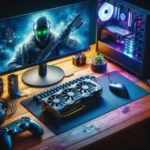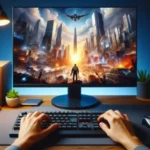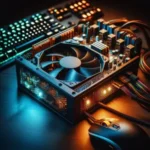In the ever-evolving world of gaming, staying ahead of the curve often means pushing the limits of your hardware to achieve that coveted peak performance.
Whether you’re a casual player seeking smoother gameplay or a competitive gamer aiming for a tactical edge, upgrading your PC can make all the difference. From enhancing graphics and reducing load times to improving system responsiveness, the right upgrades can transform your gaming experience into something truly exhilarating. In this comprehensive guide, we’ll explore everything you need to know about leveling up your gaming rig, including selecting the best components, optimizing your setup, and troubleshooting common issues. Join us as we dive into the exciting realm of PC upgrades, ensuring that your gaming sessions are not only enjoyable but also a testament to your dedication and passion for the game. Get ready to unleash the full potential of your gaming experience!
1. Introduction: Why Upgrade Your PC?
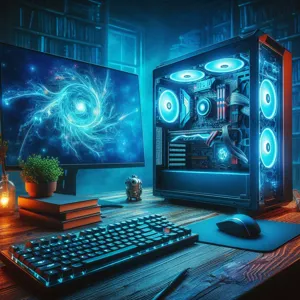
In today’s fast-paced digital landscape, the performance of your PC can significantly impact not just your productivity, but also your overall experience—whether you’re gaming, designing, or simply browsing the web. If you’ve ever found yourself waiting for a program to load or experiencing lag during an intense gaming session, you know how frustrating it can be. Upgrading your PC is not just about enhancing speed; it’s about unlocking its full potential and ensuring that it meets your evolving needs.
With technology advancing at an unprecedented rate, older systems can quickly become outdated, struggling to keep up with the latest software and applications. In gaming, for instance, the demand for higher graphics, faster processing speeds, and increased memory has never been greater. Similarly, creative professionals looking to run resource-intensive applications like video editing software or 3D modeling tools will find that an upgrade can save them hours of rendering time and enhance their workflow.
Moreover, upgrading your PC can be a cost-effective solution compared to purchasing a brand-new system. By replacing specific components—such as your graphics card, processor, or RAM—you can breathe new life into your machine without the hefty price tag of a complete overhaul. This not only extends the lifespan of your hardware but also allows for a tailored approach to meet your specific requirements.
In this guide, we will delve into the myriad reasons why upgrading your PC can be beneficial. From enhanced performance and improved multitasking capabilities to greater energy efficiency and the ability to run the latest applications, we’ll explore the advantages that come with investing in your system. Whether you’re a casual user or a dedicated gamer, understanding the importance of upgrading your PC can help you make informed decisions that lead to a superior computing experience. So, let’s embark on this journey to elevate your gaming and computing performance to new heights!
2. Assessing Your Current Hardware: What to Check
Before diving headfirst into the world of upgrades, it’s crucial to take a moment to assess your current hardware. This step is not just about knowing what components you have; it’s about understanding how they interact and where the bottlenecks in your system lie. A comprehensive evaluation can save you time and money, ensuring that you invest in the right upgrades that will yield the most significant performance improvement.
Start with your CPU, the brain of your computer. You’ll want to check its model and clock speed, as well as its core count. Is it struggling to keep up with demanding applications or games? Tools like CPU-Z can provide detailed information about your processor’s performance, helping you determine if an upgrade is necessary.
Next, turn your attention to your RAM. How much do you currently have, and what type is it? For most modern gaming and multitasking needs, 16GB is becoming the standard, while serious gamers and content creators may benefit from 32GB or more. Use a tool like Task Manager to monitor your memory usage during your typical workload; if you’re consistently maxing out your RAM, it’s time to consider an upgrade.
Your GPU is another critical component, especially if you’re into gaming or graphic-intensive tasks. Identify your graphics card model and check its performance against current benchmarks. If you find that your frame rates are suffering in the latest games or your rendering times are longer than you’d like, it may be time to invest in a new graphics card.
Finally, don’t overlook your storage options. Traditional hard drives (HDDs) can significantly slow down your system, while solid-state drives (SSDs) offer much quicker data access speeds. Assess how much storage you have and whether it’s enough for your needs. If you’re running low and relying on an HDD, consider upgrading to an SSD for faster load times and an overall snappier system.
By carefully evaluating each of these components, you’ll create a clear picture of your current setup’s strengths and weaknesses. This foundational understanding will empower you to make informed decisions as you embark on your upgrade journey, ensuring that your investment translates into tangible performance gains.
3. Setting Your Goals: Gaming vs. Multitasking Performance
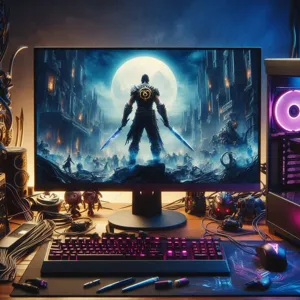
When it comes to upgrading your PC, the first step in ensuring you achieve peak performance is to clearly define your goals. Are you primarily a gamer, or do you value multitasking across various applications? Understanding your primary use case will inform the choices you make regarding which components to upgrade.
For gamers, performance is often measured in frames per second (FPS), graphical fidelity, and the ability to handle demanding titles seamlessly. If your goal is to play the latest AAA games at ultra settings, then investing in a powerful graphics card should be at the top of your list. Look for GPUs that offer high clock speeds and ample VRAM, as these features will ensure smooth gameplay even in graphically intensive scenarios. Additionally, pairing your GPU with a fast processor and sufficient RAM will help eliminate bottlenecks, ensuring that your gaming experience is as fluid as possible.
On the other hand, if multitasking is your primary focus—whether for content creation, video editing, or running multiple programs simultaneously—you’ll want to prioritize different aspects of your build. A robust CPU with multiple cores and threads will be essential for handling demanding tasks, while an upgrade to your RAM capacity can significantly enhance your system’s ability to juggle various applications without a hitch. Consider investing in an SSD for faster load times and quick file access, which can dramatically improve your workflow efficiency.
Ultimately, setting clear goals based on your gaming or multitasking needs will streamline your upgrade process, helping you to allocate your budget effectively and maximize your PC’s potential. By understanding the demands of your primary activities, you can make informed decisions that lead to a noticeable performance boost, whether you’re diving into a virtual world or tackling a hefty project.
4. Budgeting for Your Upgrade: Cost vs. Benefit
When it comes to upgrading your PC, understanding the balance between cost and benefit is crucial for maximizing your investment. Before diving headfirst into the latest hardware or software, take a moment to assess your current setup and your specific needs. This begins with a comprehensive inventory of your existing components—CPU, GPU, RAM, and storage—to determine what truly requires an upgrade.
Next, set a realistic budget that aligns with your upgrade goals. The world of PC components can be overwhelming, with prices ranging from budget-friendly to premium options that promise cutting-edge performance. Prioritize your upgrades based on the activities you engage in most frequently. For instance, if you’re a gamer, investing in a high-quality graphics card might offer the most noticeable improvement in your gaming experience. Conversely, if you’re a content creator, a faster processor and more RAM could significantly enhance your productivity.
Once you’ve identified which components to upgrade, compare the potential benefits against their costs. Research benchmarks and reviews to understand how much performance you can expect from each upgrade. This will help you avoid overspending on a component that doesn’t provide a marked improvement in performance for your specific needs.
Additionally, consider the longevity of your investment. Sometimes, spending a little more upfront on higher-quality components can save you money in the long run by delaying the need for future upgrades. Remember, PC upgrades are not merely an expense—they’re an investment in your computing experience. By thoughtfully budgeting and weighing the cost against the benefits, you can ensure that each dollar spent contributes to a more powerful and efficient system, ultimately leveling up your entire gaming experience.
5. Choosing the Right Components: CPU, GPU, and RAM
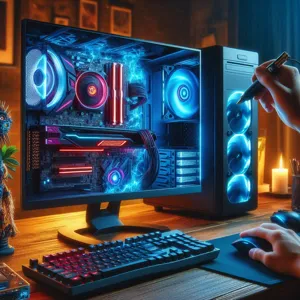
When it comes to upgrading your PC for peak performance, selecting the right components is paramount. Each part of your system plays a crucial role in determining how well your machine performs, and understanding the intricacies of the CPU, GPU, and RAM will empower you to make informed decisions that can dramatically enhance your gaming experience.
**CPU (Central Processing Unit)**
The CPU is often referred to as the brain of your computer, and for good reason. It processes instructions and manages tasks, making it essential for overall system performance. When choosing a CPU, consider the number of cores and threads, as well as the clock speed. A higher core count allows for better multitasking and improved performance in CPU-intensive games, while a faster clock speed can significantly boost your gaming frame rates. Popular options include AMD’s Ryzen series and Intel’s Core processors, which offer various models to suit different budgets and performance needs.
**GPU (Graphics Processing Unit)**
The GPU is the powerhouse behind your gaming visuals, rendering images, animations, and video in real-time. In the gaming world, this component is often the most critical for achieving stunning graphics and smooth gameplay. When selecting a GPU, look for models that align with your gaming resolution and refresh rate. For instance, if you’re gaming at 4K resolution, you’ll want a high-end graphics card such as NVIDIA’s RTX 30 series or AMD’s RX 6000 series to ensure you can keep up with demanding titles. Additionally, consider the VRAM (video RAM)—more VRAM allows for better performance in graphically intensive games and higher settings.
**RAM (Random Access Memory)**
RAM is the short-term memory of your computer, allowing for quick data access and storage for the applications and games you’re currently running. While it may not have the same immediate impact on graphics as the GPU, having sufficient RAM is crucial for smooth multitasking and fast load times. For gaming, a minimum of 16GB is recommended, but as games become increasingly complex, consider upgrading to 32GB for future-proofing and enhanced performance. Additionally, pay attention to the speed of the RAM (measured in MHz) and ensure it is compatible with your motherboard.
In summary, selecting the right components—CPU, GPU, and RAM—requires careful consideration of your gaming needs and budget. By understanding the roles each part plays, you can tailor your upgrades to create a balanced system that excels in performance, ensuring you can enjoy your favorite titles at their best. With the right components in place, you’ll be well on your way to leveling up your gaming experience.
6. Understanding Motherboards and Compatibility
When it comes to upgrading your PC, understanding motherboards and their compatibility is crucial. The motherboard is the backbone of your system, connecting all the components and allowing them to communicate with each other. It serves as the foundation upon which your entire build stands, making it imperative to choose wisely.
First and foremost, you need to consider the form factor of the motherboard. Common sizes include ATX, Micro-ATX, and Mini-ITX. The form factor not only influences the physical dimensions of the motherboard but also determines how many components you can install, such as RAM slots and PCIe slots for graphics cards. If you’re looking to upgrade your system for gaming or heavy multitasking, an ATX motherboard might be the ideal choice due to its larger size and greater expandability.
Next, you must pay attention to the chipset on the motherboard. This is the chip that governs communication between the CPU, RAM, and other components. Different chipsets come with varying features, such as support for overclocking, multiple graphics cards, or advanced connectivity options. Make sure to research which chipset is compatible with your CPU, as this will dictate your motherboard choices.
Additionally, you’ll want to verify that your new motherboard supports the type of RAM you plan to use. Check the RAM slots for compatibility with DDR4 or DDR5 memory and ensure you know the maximum supported speed and capacity. If you’re planning to expand your memory in the future, having a motherboard with additional RAM slots can save you from needing another upgrade down the line.
Lastly, don’t forget about connectivity options. Look for a motherboard that provides ample USB ports, Thunderbolt support, or onboard Wi-Fi if you need these features. Whether you plan to connect multiple peripherals or prefer a clean, wireless setup, having a motherboard that meets your connectivity needs will enhance your overall experience.
In conclusion, understanding motherboards and compatibility is a foundational step in upgrading your PC for peak performance. Take the time to research and select a motherboard that not only meets your current requirements but also allows for future growth, ensuring your system remains powerful and relevant for years to come.
7. Solid-State Drives vs. Hard Drives: Storage Upgrades
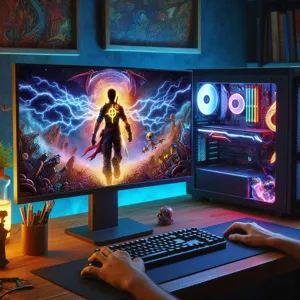
When it comes to upgrading your PC’s storage, understanding the difference between Solid-State Drives (SSDs) and Hard Disk Drives (HDDs) is crucial for optimizing performance. The choice between these two storage types can significantly impact your system’s responsiveness, speed, and overall user experience.
**Solid-State Drives (SSDs)** are the modern powerhouse of storage solutions. Unlike traditional hard drives, which rely on spinning disks and mechanical arms to read and write data, SSDs use flash memory to store information. This means they have no moving parts, resulting in faster data access times, quicker boot-ups, and snappier application launches. If you’ve ever experienced the frustration of waiting for your PC to start or load a game, switching to an SSD can feel like a revelation. Not only do they improve speed, but SSDs also consume less power, generate less heat, and are more resistant to physical shock, making them a smart choice for gamers and professionals alike.
On the other hand, **Hard Disk Drives (HDDs)** still have their place in the storage hierarchy. They offer larger capacities at a lower price point, making them suitable for users who need a lot of space without breaking the bank. If you’re looking to store vast amounts of data—such as large game libraries, videos, or backups—HDDs can provide the bulk storage that SSDs lack, even though they may lag in speed. Many users opt for a hybrid approach, using an SSD for their operating system and frequently used applications, while relying on an HDD for mass storage needs.
When considering storage upgrades, think about your usage patterns. If you prioritize speed and performance, an SSD is the way to go. However, if you’re managing a vast media collection or working with large files, pairing an SSD with an HDD can yield the best of both worlds. In either case, upgrading your storage to include an SSD is one of the most transformative enhancements you can make to your PC, elevating your gaming experience and productivity to new heights.
8. Cooling Solutions: Keeping Your PC Running Smoothly
When it comes to upgrading your PC for peak performance, one aspect that often gets overlooked is the importance of effective cooling solutions. As your hardware components work harder and faster, they generate heat—sometimes, an alarming amount of it. If this heat isn’t managed efficiently, it can lead to thermal throttling, reduced performance, and even permanent damage to your components. Therefore, investing in a robust cooling system is not just a luxury; it’s a necessity for those serious about gaming or demanding applications.
There are various cooling solutions available, each with its own pros and cons. Air cooling remains the most popular choice for many PC builders due to its simplicity and cost-effectiveness. High-quality air coolers often feature large heatsinks and multiple fans that can dissipate heat effectively. Brands like Noctua and be quiet! offer exceptional models that provide excellent cooling performance while maintaining low noise levels.
However, for those seeking to push their systems to the limits, liquid cooling presents a more advanced option. Liquid coolers, either in an all-in-one (AIO) format or as custom loops, use a liquid coolant to absorb heat from the CPU and GPU before dissipating it through radiators. This method not only enhances cooling efficiency but also adds a sleek aesthetic to your build. A well-set-up liquid cooling system can keep temperatures significantly lower than traditional air cooling, allowing for higher overclocks and better performance in demanding scenarios.
It’s also crucial to consider airflow within your case. proper cable management, strategically placed fans, and even case design can vastly influence how well your cooling solution performs. Ensure that there’s a clear path for air to flow in and out of your system, reducing hotspots that can lead to overheating.
In summary, prioritizing cooling solutions is essential for maintaining your PC’s performance and longevity. Whether you opt for air or liquid cooling, keeping temperatures under control will not only enhance your gaming experience but also ensure that your upgraded components continue to perform at their best for years to come.
9. Power Supplies: Ensuring Reliable Performance
When it comes to upgrading your PC for peak performance, one component that often gets overlooked is the power supply unit (psu). However, ensuring that you have a reliable and efficient power supply is crucial for the stability and longevity of your system. A high-quality PSU acts as the backbone of your PC, delivering consistent power to all your components and preventing potential failures caused by power fluctuations.
First and foremost, it’s essential to choose a PSU with sufficient wattage to support your hardware. When upgrading your CPU, GPU, or adding new components, keep in mind that each part has specific power requirements. It’s recommended to calculate your system’s total power draw using online calculators that take into account each component’s consumption. This will help you select a PSU that not only meets but exceeds your system’s needs, providing headroom for future upgrades.
Additionally, pay attention to the efficiency rating of the power supply. Look for units that are certified by the 80 PLUS program, which indicates their efficiency at various load levels. A higher efficiency rating—such as Gold or Platinum—means less wasted energy, lower electricity bills, and less heat generated within your case. This is particularly important for high-performance setups that may run under heavy loads for extended periods.
Another critical factor to consider is the PSU’s build quality and features. Opt for models with reputable brands known for their reliability and robust construction. Look for features such as modular cables, which allow for better cable management and airflow within your case; this can lead to improved cooling and easier maintenance. Furthermore, a PSU with built-in protections against over-voltage, under-voltage, and short circuits will help safeguard your valuable components from unexpected issues.
Finally, don’t underestimate the importance of noise levels. Silent operation is a desirable feature, especially for gamers and professionals who need a quiet environment. Many modern power supplies come with fan control technologies that adjust the fan speed based on temperature, allowing for near-silent performance during light loads.
In summary, when upgrading your PC, don’t skimp on the power supply. By investing in a high-quality PSU, you ensure that your system runs reliably and efficiently, allowing you to fully unleash the potential of your upgraded components. A dependable power supply lays the groundwork for a powerful and stable gaming or productivity experience, making it an essential part of your performance enhancement journey.
10. Upgrading Peripherals: Monitors, Keyboards, and Mice
When it comes to upgrading your PC for peak performance, enhancing your peripherals—such as monitors, keyboards, and mice—can make a significant difference in your overall experience. Often overlooked, these components play a vital role in how effectively you can utilize your upgraded hardware. Let’s delve into how each of these peripherals can elevate your gaming and productivity to new heights.
**Monitors:** A high-quality monitor is the centerpiece of your setup. Investing in a display with a higher resolution, such as 1440p or 4K, will provide stunning visuals that bring your games and applications to life. Additionally, consider a monitor with a high refresh rate (at least 144Hz) and low response time for smoother gameplay and reduced motion blur. Features like G-Sync or FreeSync can further enhance your gaming experience by synchronizing the display refresh rates with your graphics card, eliminating screen tearing. Don’t forget about ergonomics—an adjustable stand or VESA mount can help you find the perfect viewing angle, reducing strain during those marathon gaming sessions.
**Keyboards:** The keyboard is your primary tool for interaction, so why settle for anything less than exceptional? Mechanical keyboards, with their tactile feedback and customizable switches, offer a superior typing experience and can significantly enhance your gaming performance. Look for keyboards with programmable keys that allow for macros, giving you the ability to execute complex commands with a single press. Backlighting is another feature to consider, not only for aesthetics but also for improved visibility in low-light conditions. Whether you prefer a compact layout or a full-sized keyboard with a number pad, find one that complements your gaming style.
**Mice:** A responsive and comfortable mouse is crucial for precision, especially in fast-paced gaming environments. Opt for a gaming mouse with adjustable DPI settings to tailor sensitivity to your preferences, allowing for quick movements or precise targeting as the situation demands. Ergonomics should be a top priority; a mouse that fits comfortably in your hand can prevent fatigue during extended use. Many gaming mice also come with customizable buttons and weight adjustments, giving you the flexibility to design your ideal setup.
In summary, upgrading your peripherals can significantly impact both your gaming and workflow efficiency. Take the time to choose monitors, keyboards, and mice that not only meet your performance needs but also enhance your overall PC experience. By investing in these components, you’ll not only elevate your gameplay but also create a more enjoyable and productive environment that keeps you coming back for more.
11. Installing New Hardware: Step-by-Step Guide
Upgrading your PC can feel like a daunting task, especially when it comes to installing new hardware. However, with the right approach and a little patience, you can transform your system into a high-performance machine. Here’s a step-by-step guide to help you through the process.
**1. Gather Your Tools and Components**
Before diving in, ensure you have all the necessary tools at hand. A Philips screwdriver, anti-static wrist strap, and a clean workspace will make the installation much easier. Additionally, gather your new hardware components—whether it’s a graphics card, additional RAM, or a new SSD. Make sure all the parts are compatible with your motherboard and existing setup.
**2. Power Down and Disconnect**
Begin by shutting down your PC and unplugging it from the power source. This is crucial for your safety and to prevent any damage to your components. Disconnect all peripherals, including monitors, keyboards, and mice, to give yourself ample space to work.
**3. Open the Case**
Carefully remove the side panel of your computer case. Most cases have screws or thumb latches that allow you to access the inner workings. After removing the panel, take a moment to familiarize yourself with the layout of your PC, including where the existing hardware is located.
**4. Ground Yourself**
To prevent static electricity from damaging your components, ground yourself by wearing an anti-static wrist strap or frequently touching a metal part of the case. This simple step can save you from costly mistakes.
**5. Install the New Hardware**
Now comes the exciting part—installing your new hardware! If you’re adding RAM, locate the RAM slots and gently push down on the new sticks until they click into place. For a graphics card upgrade, find the PCIe slot, remove any protective covers, and firmly insert the card until it locks in. If you’re installing a new SSD or HDD, slide it into the designated bay and connect the necessary cables.
**6. Connect Cables and Power On**
After everything is securely installed, check that all cables are connected properly. This includes power cables for any new components and data cables for storage devices. Once you’re sure everything is in place, replace the side panel of your case and reconnect all peripherals.
**7. Boot Up and Install Drivers**
Power on your PC and be ready to enter the bios if necessary. Ensure that your new hardware is recognized. Once booted into your operating system, install any required drivers for your new components. This is essential for optimal performance and stability.
**8. Test and Optimize**
Finally, it’s time to test your system. Run benchmarks or your favorite games to see how the new hardware performs. Monitor temperatures and make adjustments in your system settings if needed. This is also a great time to explore any software that can help you optimize performance, such as overclocking tools or system monitoring applications.
By following these steps, you can confidently upgrade your PC hardware, unlocking new levels of performance for gaming, content creation, or any other demanding tasks. Each upgrade not only enhances your experience but also extends the life of your machine, ensuring you’re always ready for the next big challenge.
12. Software Optimization: Drivers and Operating Systems
When it comes to maximizing your PC’s performance, software optimization is just as crucial as hardware upgrades. One of the first steps in this process is ensuring that your drivers are up to date. Drivers act as the communication bridge between your operating system and your hardware components, such as your graphics card, sound card, and even your motherboard. Outdated drivers can lead to compatibility issues, reduced performance, and even system crashes. To keep your system running smoothly, regularly check the manufacturer’s website for the latest driver releases, or use a dependable driver update tool that automates the process for you.
Equally important is the health of your operating system. Over time, your OS can accumulate unnecessary files, outdated applications, and even malware, all of which can slow down your computer. Conducting routine maintenance, like disk cleanup and defragmentation, can significantly enhance your system’s responsiveness. Furthermore, consider disabling startup programs that aren’t essential; this will free up system resources and speed up boot times.
Another vital aspect of software optimization is managing your operating system settings. Tweaking settings such as visual effects, power options, and background processes can lead to a substantial boost in performance. For gamers, enabling Game Mode in windows 10 or later can prioritize system resources towards your gaming applications, reducing lag and improving frame rates.
Don’t forget to keep an eye on your system’s performance metrics. Tools like Task Manager or third-party software can provide insights into resource usage, helping you identify any bottlenecks. By systematically keeping your drivers and operating system optimized, you’ll create a robust foundation upon which to build your upgraded PC experience, ensuring that every component operates at its peak potential.
13. Benchmarking Your Performance: Testing After Upgrades
Once you’ve made upgrades to your PC, whether it be a new graphics card, additional RAM, or a faster SSD, the next crucial step is benchmarking your performance. Benchmarking isn’t just about seeing numbers; it’s about understanding how your upgrades translate into real-world improvements for your gaming or productivity experience.
Start by using reliable benchmarking software such as 3DMark for graphics performance, Cinebench for CPU capabilities, or UserBenchmark for an overall system assessment. These tools will run a series of tests designed to push your hardware to its limits and provide you with performance scores that you can compare against previous results or industry averages.
As you run these benchmarks, take note of key metrics like frame rates, load times, and overall system responsiveness. For gamers, a significant jump in frames per second (FPS) can mean the difference between a smooth gameplay experience and frustrating stutter. For content creators, faster render times can significantly enhance productivity, allowing you to spend more time creating and less time waiting.
After conducting your benchmarks, it’s essential to analyze the results. Look for areas where your upgrades made the most impact and consider whether there are still bottlenecks in your system. For instance, if you upgraded your GPU but noticed that your CPU is still struggling to keep up, it might be time to consider a CPU upgrade as well.
Lastly, don’t forget to keep your benchmarking software updated, as new versions may include tests that reflect the latest gaming titles or software applications. Regularly benchmarking your system after each upgrade will not only help you track your performance improvements over time but will also ensure that your PC runs at its peak, providing you with the ultimate gaming or working experience. By keeping a close eye on your performance metrics, you can make informed decisions about future upgrades and maintain a system that consistently meets your demands.
14. Maintenance Tips: Keeping Your PC in Top Shape
Maintaining your PC is just as crucial as upgrading its hardware. A well-maintained system not only performs more efficiently but also extends the lifespan of your components, ensuring you get the most out of your investment. Here are some essential maintenance tips to keep your PC in top shape.
**1. Regular Dusting and Cleaning:** Dust is the enemy of any computer. It can clog fans and vents, leading to overheating and decreased performance. Make it a habit to open up your case every few months and gently remove dust using compressed air. Pay special attention to the CPU cooler, power supply, and GPU fans. Additionally, clean your keyboard and monitor regularly to prevent buildup and smudges.
**2. Software Updates:** Keep your operating system, drivers, and software updated. Manufacturers release updates to fix bugs, improve performance, and patch security vulnerabilities. Enable automatic updates where possible, but also check periodically to ensure everything is current.
**3. Disk Cleanup and Defragmentation:** Over time, your hard drive accumulates unnecessary files that can slow down your system. Use built-in tools like Disk Cleanup on Windows to remove temporary files, system files, and empty your recycle bin. If you’re using a traditional HDD (not SSD), consider running a defragmentation tool to reorganize fragmented data, boosting access speeds.
**4. Monitor Your System’s Health:** Keep an eye on the temperature of your CPU and GPU, as well as the health of your drives. Software tools like HWMonitor or CrystalDiskInfo can provide real-time stats and alerts if something is off. This early detection can prevent catastrophic failures down the line.
**5. Backup Your Data:** Regularly back up your data to an external drive or a cloud service. This precautionary measure ensures that in the event of hardware failure or data corruption, you won’t lose your important files and documents.
**6. Manage Startup Programs:** Too many programs launching at startup can bog down your system’s boot time and overall performance. Use the Task Manager (Windows) or System Preferences (Mac) to disable unnecessary startup items.
**7. Check for Malware:** Malware can severely impact your system’s performance and security. Install reliable antivirus software and conduct regular scans to keep your PC safe from harmful threats.
By incorporating these maintenance tips into your routine, you can ensure that your PC remains a powerhouse of performance. Regular care not only enhances your gaming experience but also saves you from unexpected repairs and replacements, allowing you to focus on leveling up your game.
15. Conclusion: Enjoying Your Upgraded Gaming Experience
As you reach the end of this comprehensive guide on upgrading your PC for peak gaming performance, it’s time to savor the rewards of your hard work and investment. Picture this: you’ve meticulously chosen and installed every component, from the latest graphics card that renders stunning visuals to the lightning-fast SSD that minimizes load times. Now, it’s time to indulge in that upgraded gaming experience you’ve been anticipating.
Imagine launching your favorite title, the screen bursting to life with vivid colors and intricate details that transport you into another world. Each frame flows seamlessly, thanks to your optimized hardware—no more stutters or lag to disrupt your immersion. Whether you’re battling fierce opponents in a competitive match or exploring sprawling virtual landscapes, your upgraded setup ensures that every moment is exhilarating.
But it’s not just about the graphics; it’s about the entire ecosystem you’ve created. With enhanced cooling solutions, your system runs quieter and cooler, allowing you to focus on what truly matters: the game. The responsiveness of your new peripherals—the mechanical keyboard that gives tactile feedback with every click, the high-DPI gaming mouse that glides effortlessly—adds another layer of satisfaction to your gameplay.
Beyond the immediate thrill of gaming, remember that this upgrade is an investment in your passion. You’ve positioned yourself to dive into the latest releases and immerse yourself in expansive worlds that push the boundaries of technology. And as you take on new challenges, don’t forget to share your journey with fellow gamers. Join forums, stream your gameplay, or connect on social media to showcase your achievements and the triumphs of your upgraded rig.
So, take a moment to revel in your success. Your upgraded gaming PC isn’t just a collection of components; it’s a gateway to countless adventures and unforgettable memories. Enjoy every pixel, every sound, and every victory, knowing that you’ve leveled up not just your machine, but your entire gaming experience. Happy gaming!
As we wrap up our comprehensive guide on upgrading your PC for peak performance, we hope you’re feeling inspired and equipped to take your gaming experience to the next level. By carefully assessing your current setup and making thoughtful upgrades—whether it’s enhancing your graphics card, boosting your RAM, or optimizing your cooling system—you can unlock a whole new realm of gaming potential. Remember, investing in the right components not only enhances your gameplay but also extends the lifespan of your system. So gear up, dive into the world of upgrades, and get ready to conquer your favorite games with unparalleled speed and visual fidelity. Happy gaming, and may your performance always be at its peak!

